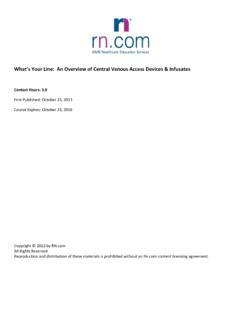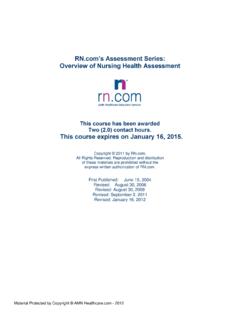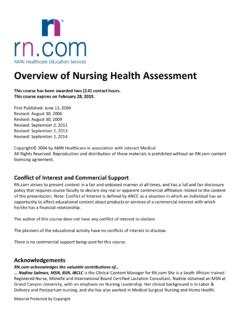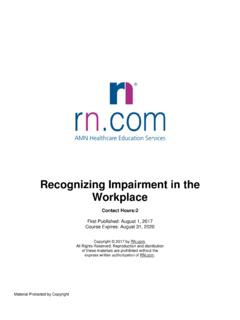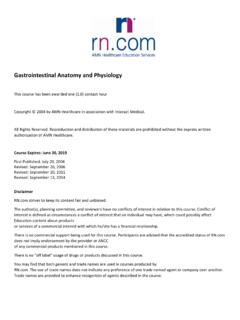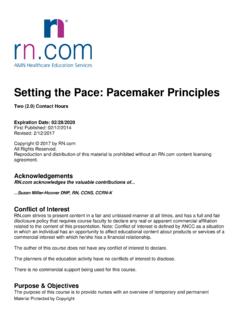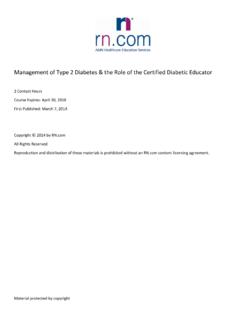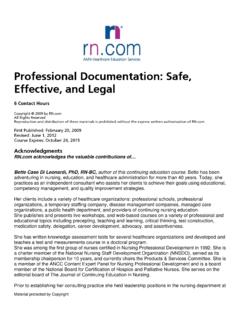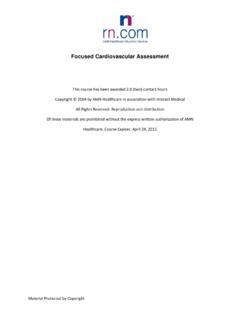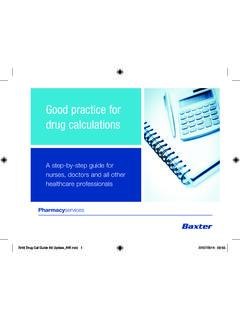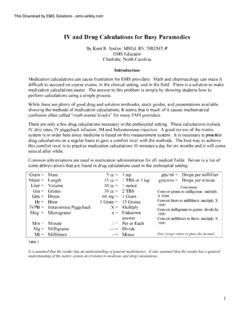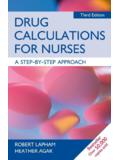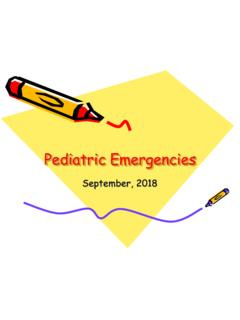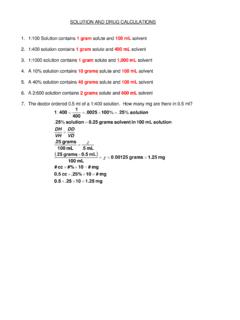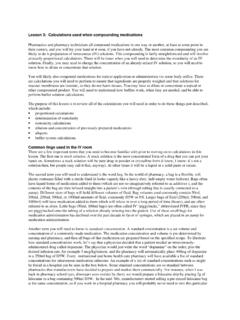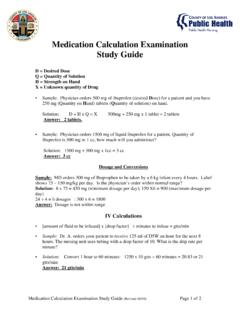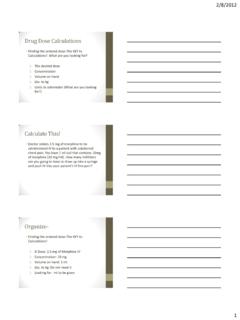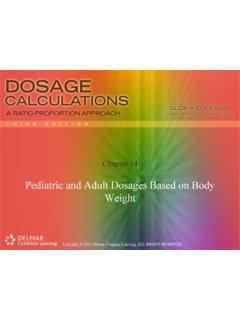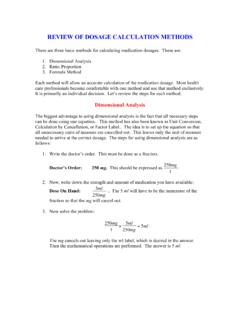Transcription of Critical Thinking: Nursing Calculations Part 1 - RN.com
1 Material protected by copyright. Critical thinking : Nursing Calculations part 1 This course has been awarded three ( ) contact hours. This course expires on September 30, 2019. Copyright 2003 by All Rights Reserved. Reproduction and distribution of these materials are prohibited without the express written authorization of First Published: November 14, 2003 Revised: November 14, 2006 Revised: December 09, 2008 Revised: November 20, 2012 Revised: December 17, 2015 strives to keep its content fair and unbiased. The author(s), planning committee, and reviewers have no conflicts of interest in relation to this course.
2 Conflict of Interest is defined as circumstances a conflict of interest that an individual may have, which could possibly affect Education content about products or services of a commercial interest with which he/she has a financial relationship. There is no commercial support being used for this course. Participants are advised that the accredited status of does not imply endorsement by the provider or ANCC of any commercial products mentioned in this course. There is no "off label" usage of drugs or products discussed in this course. You may find that both generic and trade names are used in courses produced by The use of trade names does not indicate any preference of one trade named agent or company over another.
3 Trade names are provided to enhance recognition of agents described in the course. Note: All dosages given are for adults unless otherwise stated. The information on medications contained in this course is not meant to be prescriptive or all-encompassing. You are encouraged to consult with physicians and pharmacists about all medication issues for your patients. Material protected by copyright. Acknowledgements acknowledges the valuable contributions Kim Maryniak, RNC-NIC, MSN, PhD(c) Purpose and Objectives The purpose of Critical thinking : Nursing Calculations part I is to provide information about basic facts and principles of Calculations related to conversions between different measurement systems.
4 After successful completion of this course, you will be able to: 1. Identify reasons why nurses need to maintain competency in performing selected Calculations even though technology and pharmacy support relieves nurses of performing Calculations in many situations. 2. Describe selected basic concepts, facts and principles of algebra and mathematics. 3. Perform Calculations correctly using: A. Formula (where applicable) B. Ratio and proportion 4. Identify advantages and disadvantages of the different calculation methods: A. Formula (where applicable) B. Ratio and proportion 5. Convert correctly between selected units of measure: A.
5 Within the metric system B. Between United States customary measures and the metric system C. Between selected cooking measures and the metric system D. Between Celsius (centigrade) and Fahrenheit temperature scales Introduction As a healthcare professional, medication safety is a Critical part of your job. Patient s safety and lives may depend on receiving the correct dose of medications. This two- part series of courses reviews basic skills related to safely calculating medication dosages. part 1 of the series deals with the metric system and conversions to and from the metric system. part 2 considers Calculations related to medications.
6 Learning to master the metric system and related Calculations may seem basic, but much of what we learned about the principles of Calculations may have been forgotten. In this first part of the series, a general review of metric terms will reinforce what the terms mean. Basic Calculations related to the metric systems and conversions to and from the metric system will be addressed. Keys to calculation Success Some of those Top Ten reasons may apply to your work situation at least partially. To add further support to the list, initiatives directed toward improving medication safety recommend that Calculations be performed by computer algorithm rather than by practitioners using calculators or paper and pencil (Durham, 2015).
7 HOWEVER, responsible professionals cannot afford to become complacent and place blind trust in technology - particularly nurses, who assume accountability for all Material protected by copyright. drugs they administer. The Institute for Safe Medication Practices (ISMP) recommends the use of redundancies, such as independent double checks, of high alert medications due to the increased risk for patient harm (ISMP, 2014). This includes independent Calculations for dose and rates of medication. The list of high alert medications can be found at Top Ten Reasons Why Healthcare Professionals Don t Think They Need to Maintain Competency in Calculations 1.
8 The computer does it. 2. The pharmacy does it. 3. The IV infusion pump does it. 4. We have charts and tables that do it. 5. The drug companies take care of it. 6. We use unit dose. 7. It s just a Nursing school exercise. 8. We have a unit based pharmacist. 9. Math is just not one of my strengths. 10. It s not a good use of my time. Did You Know? One cross-sectional study was done with 203 nurses to examine medication knowledge and the risk of medical errors. Participants were from acute care hospitals and primary care settings. As part of the study, each was provided a test on pharmacology, drug management, and drug Calculations .
9 The study showed that the participants had a 39% moderate risk and 11% high risk for pharmacology knowledge, 33% moderate risk and 26% high risk with drug management, and 32% moderate risk and 7% high risk with drug Calculations (Simonsen, Johansson, Daehlin, Osvik, & Farup, 2011). Relying on Technology As previously mentioned, relying on technology alone can be detrimental to patients. Nurses are the often the last measure to keep patients safe. High risk medications and high risk populations, such as neonatal patients or those on chemotherapy are particularly at risk. Accurate Calculations of medications are vital.
10 In addition, the considerations of converting values to the metric system to input into devices, such as intravenous (IV) pumps is essential (American Association of Health-System Pharmacists, 2015; National Association of Neonatal Nurses, 2011). Examples of errors include inputting the patient s height (cm) into a pump rather than the weight (kg) (ISMP, 2011). Keys to calculation Success To prepare and administer medications safely, healthcare professionals must avoid total dependence on technology to perform Calculations . Safe practitioners question themselves to eliminate risks of harm to patients.
